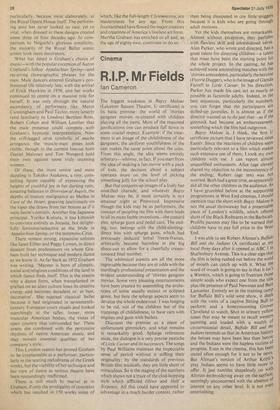Cinema
R.I.P. Mr Fields
Ian Cameron
The biggest weakness in Bugsy Malone (Leicester Square Theatre, U certificate) is its basic premise: the world of 'thirties gangster movies re-created with children playing all the parts. Most of the reasoned justifications one can produce fall down in some crucial respect. Example: if the treatment is an image of the childishness of the gangsters, the uniform youthfulness of the cast makes the same point about the cops. From this angle, the idea seems entirely arbitrary—whimsy, in fact. If you start from the idea of making a fun movie with a pack of kids, the decision about a subject operates more on the level of picking something jolly for the school play.
But that conjures up images of a lively but unskilled charade, and whatever Bugsy Malone may be, it most certainly is not amateur night at Pinewood. Impressive though the kids may be as performers, the concept of peopling the film with them leads to all its more feeble inventions—the custard Pies, splurge guns and pedal cars. The ending, :too, belongs with the child-slanting: direct hits with splurge guns, which had previously induced lethal freeze-frames, arbitrarily become harmless in the big shoot-out to allow for a cheerfully creamcovered final number.
The whimsical aspects are all the more regrettable because they are at odds with the startlingly professional presentation and the evident understanding of 'thirties gangster movies. Some very pleasing entertainments have been created by assembling the archetypes of some usually extinct or eclipsed genre, but here the splurge aspects seem to devalue the whole endeavour. I was longing to be rid, not of the children but of the trappings of childishness, to have cars with engines and guns with bullets.
Discount the premise as a piece of unfortunate gimmickry, and what remains is remarkably good. Splurge references aside, the dialogue is a very precise pastiche of Little Caesar and its successors. The songs by Paul Williams maintain the impeccable sense of period without it stifling their originality; by the standards of previous British film musicals, they are little short of miraculous. So is the staging of the numbers which shows not a trace of the clod-hopping style which afflicted Oliver and Half a Sixpence. All this could have appeared to advantage in a much harder context, rather than being dissipated in coy little sniggers because it is kids who are going through adult motions.
Yet the kids themselves are remarkable. Almost without exception, they perform with flawless skill and unrestrained verve. Alan Parker, who wrote and directed, has a great talent for directing children—a talent that must have been the starting point for the whole project. In the casting, he has achieved some astonishing matches with the 'thirties antecedents, particularly the heroine (Florrie Dugger), who is the image of Glenda Farrell in Little Caesar. In his direction, Parker has made his cast act as nearly as possible as facsimile adults. Indeed, in the best sequences, particularly the numbers, you can forget that the participants are dolled-up juveniles. It is almost as if the director wanted us to do just that—as if the gimmick had become an embarrassment, something which the film had outgrown. Bugsy Malone is, I think, the first IJ certificate picture that I have reviewed since Easter. Since the reactions of children seem particularly relevant to a film which makes such extensive use of them, [took my own children with me. I can report almost unqualified enthusiasm. Alice (age eleven) shared my objection to the inconsistency of the ending; Robert (age ten) was not worried. Both had a great time, as apparently did all the other children in the audience. As I have grumbled before at the supporting programmes in West End cinemas, I should mention that the short with Bugsy Malone is not the usual throwaway but a presentable piece of London's wildlife, which offered shots of the Black Redstarts in the Barbican. Prolific parents may like to be warned that children have to pay full price in the West End.
I was able to see Robert Altman's Buffalo Bill and the Indians (A certificate) at MY local three days after it opened at ABC I is Shaftesbury Avenue. This is a clear sign that the film is being rushed out before the word of mouth can catch up with it. What the word of mouth is going to say is that it isn't a Western, which is going to frustrate those simple souls who expect one from the title plus the presence of Paul Newman and Burt Lancaster. Entirely set in the training camP for Buffalo Bill's wild west show, it deals with the visits of a captive Sitting Bull to perform and a honeymooning Grover Cleveland to watch. Shot in urinary yellow tones that may be meant to recall western painting and loaded with a wealth of circumstantial detail, Buffalo Bill and the Indians reminds us that in American historY the heroes may have been less than heroic and the Indians were the hapless victims of progress. Even in the cinema, this has bees stated often enough for it not to be news. But Altman's version of Arthur Kopies play Indians seems to have little more to offer. It just rambles shapelessly on with Altman embroidering away on the surface; seemingly unconcerned with the absence 01 interest on any other level. It is not eves entertaining.


































 Previous page
Previous page